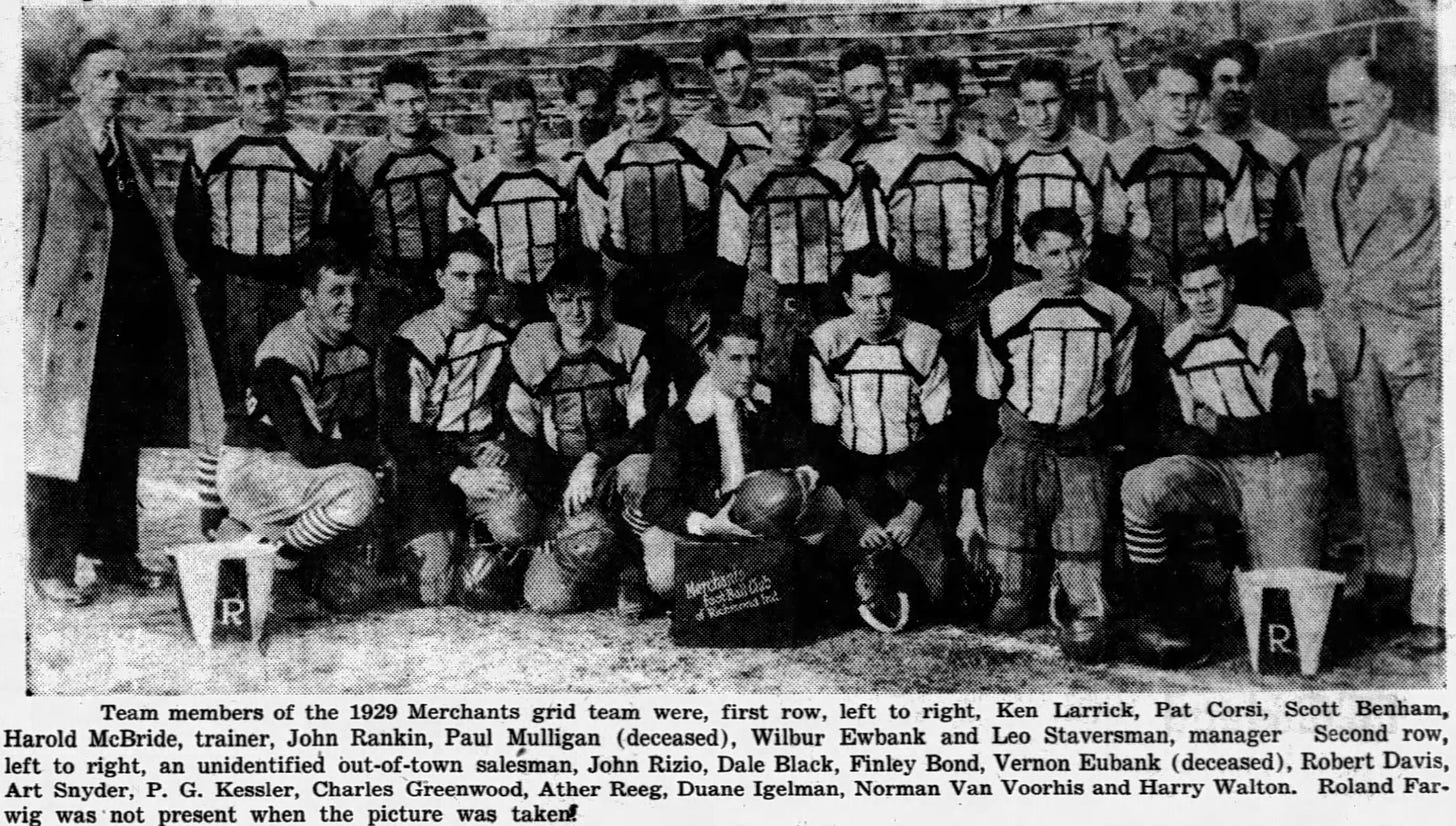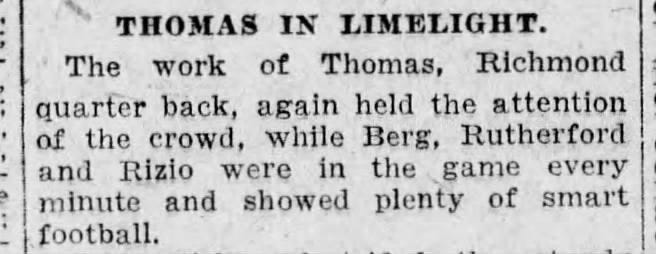The Richmond Tigers, the Ewbanks, and A Mystery Ringer
Not every story has a happy ending, and this is one of them.
I'm always looking for items that tell a story about football. Many items I acquire are valued for their visual appeal; others because they illustrate a formation, technique, or equipment that is part of the game's history. For items that concern a player or team that I am unfamiliar with, a little research helps determine whether there is a story is worth telling. Most times, there isn't, so I don't bid on the item.
I followed the second approach for the two letters shown below. One letter is from Indiana's semi-pro Richmond Tigers inviting a Portland, Indiana, team to schedule a game during the 1928 season. Early pro and semi-pro teams are not my specialty, so I had never heard of the Richmond Tigers, but the letterhead and signature block showed it came from V. C. Ewbank of 1813 Boyer Street in Richmond.
Richmond, then a town of 30,000, is located in east-central Indiana, close to the Ohio border. Many early settlers were Quakers, leading the city to become the home of Earlham College, a Quaker institution that produced Frank Birch, the creator of football's referee signaling system. Richmond was also home to many lawn mower manufacturers, so many townspeople worked in those factories.

Pro football was still rinky-dink in the 1920s. The NFL had teams from small towns and big cities that came and went from one season to the next. Besides the NFL, a host of other leagues and independent teams popped up across the country that lasted a few years, with their success dependent on which local boys chose to play for a few bucks per week. There was no clear separation between semi-pro and pro teams. NFL teams regularly scheduled exhibition games with semi-pro and all-star teams before, during, and after the season. Teams played whoever they could schedule to make a buck.
The Richmond Tigers were one of those semi-pro, bordering on professional, teams, but were not good enough to play NFL teams. They played games in 1924, did not play in 1925, but returned to action in 1926 and were successful, claiming to be Indiana's professional football champion. Like other teams of the era, their money primarily came from home ticket sales, guarantees for playing away games, and sponsorship money. The Tigers' sponsors differed year to year, leading the newspapers to variously call them the Richmond Tigers, the Worthmore Tigers, the Empire Tigers, or the Richmond Merchants. The Tigers' opponents included stalwarts such as the J. J. Cumming All-Stars of Indianapolis (referred to as the J.J.C.s in the letter), the Indianapolis ex-Collegians, the Dunkirk Ita-Nick-Nicks, and the Portland Our Boys.
The second letter is identical to the first, except for being addressed to the Cincinnati National Guard football team manager. Since the two letters came from the same source, they likely were never mailed and came down through the Ewbank family or someone involved with the Richmond Tigers team. As with the first letter, the letterhead lists V. C. Ewbank as the team manager and Bruno Thomas as the coach. Despite substantial searching, I found only one reference to Bruno Thomas being the team’s coach. Those references mention that he was also the team’s quarterback. Still, Bruno Thomas does not appear to have played or coached football for another team, neither does he have genealogical records tied to Richmond. Of course, I might have missed him, but I'll soon explain my guess as to Bruno Thomas' true identity.
V. C. Ewbank, on the other hand, regularly appeared in the newspapers as a player and manager of various Richmond baseball and football teams in the late 1910s and 1920s. In some articles, he shows up as V. Ewbank, and I eventually figured out he was Vernon Clair Ewbank based on a link related to him serving in the Army during WWI. Once I knew his full name, I found him in the 1910 Census as a 9-year-old living with his parents on Boyer Street, the same address listed on the Richmond Tigers letterhead.
Vernon had a 7-year-old sister, Helen, and a 3-year-old brother, Wilbur C. Another brother, Myron, arrived a few years after the 1910 Census. Wilbur C. Ewbank may not be a name you recognize, but little Myron had trouble pronouncing Wilbur, so he called his older brother Weeb. Weeb starred on the local gridiron, diamond, and court before heading to Miami University, about 25 miles east of Richmond. Only 5' 7", Weeb had a rifle arm as a centerfielder, played forward on the basketball team, and was a backup quarterback, who played a lot.
After Weeb graduated, sophomore Paul Brown took over the quarterback spot at Miami. Later, Brown became the head coach at Ohio State, and when he took over the Great Lakes Naval Training Station football team during WWII, Weeb joined him as an assistant coach, which provided Weeb's big break. After working with Paul Brown as an assistant with the Cleveland Browns, Weeb took the Baltimore Colts' head job, leading them to the NFL title in 1958 and 1959. The 1958 overtime victory is often called "the greatest game ever played." He also coached the New York Jets to victory in Super Bowl III after Joe Namath guaranteed the upstart AFL team would beat the Colts.
So, the Richmond Tigers letter has a brotherly connection to NFL royalty, but was there a more direct connection to Weeb? The Tigers letter is a solicitation for a 1928 game, by which time Weeb had graduated from Miami and was coaching an Ohio high school team. Weeb was the Tigers' starting quarterback during the 1928 and 1929 seasons.


More interesting than Weeb's quarterbacking the 1928 and 1929 teams is his role during the 1926 and 1927 seasons when he was still playing for Miami. The Tigers' box scores during the early season show their quarterback was McBride or Harding, but Shorty Thomas became the regular quarterback as the season wore on. He earned rave reviews from the Richmond newspapers and those covering the opposing teams. For example, the Tigers earned a November 1926 victory over Indiana's strongest pro team, with Thomas at QB. The preview of the game when they played a week later touted Thomas' value:
Following the rematch, Thomas was again praised for his play:
Despite Thomas being one of the team’s stars, a news report about the team banquet following the 1926 season listed Weeb Ewbank as one of the Tigers players and made no mention of quarterbacks McBride, Harding, or Shorty Thomas. How could that be?
Later in life, Weeb Ewbank acknowledged that he played football for Miami on Saturdays as Weeb Ewbank while playing for the Tigers on Sundays as "Shorty" Thomas. (The real Shorty Thomas was a childhood friend from Richmond.) Ewbank also claimed that he started making money from sports as a high school sophomore, so the local reporters who had seen him play in high school and around town knew the Tigers' quarterback was Ewbank, not Thomas, but they participated in the charade. Likewise, Miami's trainer, who once asked Ewbank why he was limping so badly on a Monday after playing sparingly on Saturday, was in on the hustle.
Since Weeb used the Shorty Thomas identity while playing for the Tigers, the Bruno Thomas listed as the coach on the letterhead is likely another element of the deception. Weeb, aka Shorty or Bruno Thomas, called the signals as the quarterback and acted as the coach on the field, while his brother Vernon handled the financial and other managerial tasks.
Weeb went on to tremendous success in football, but Vernon did not have that opportunity as he met with tragedy on a September evening in 1933. Vernon was a machinist in town and met up with several female friends early that evening; they later joined some male friends as the group spent a long evening carousing in Richmond. Late in the evening, one of the men slapped one of the women, leading Vernon to intervene. A bit later, the two renewed their fight while in the back seat of a car. Struck in the head, Vernon collapsed and died of a brain hemorrhage. The assailant later pled guilty to manslaughter charges, spending two years in prison.
In today's media environment, we might expect Vernon’s death to be raised in stories profiling Weeb, but Vernon's death does not appear to have been a topic raised during Weeb's coaching years. Instead, the story went unspoken, only to be revealed by investigating a few letters Vernon wrote when trying to schedule some football games back in 1928.
Click here for options on how to support this site beyond a free subscription.








Congratulations on a brilliant piece of research! Maybe you can parlay this into a book. I have long felt that Weeb is somewhat underrated, despite having been enshrined in Canton. I mean...the coach behind Unitas and Namath. It's possible that (like Yogi Berra) his squat appearance has kept him out of the limelight.
Wow, that is some great detective work Sherlock Brown! Loved the story